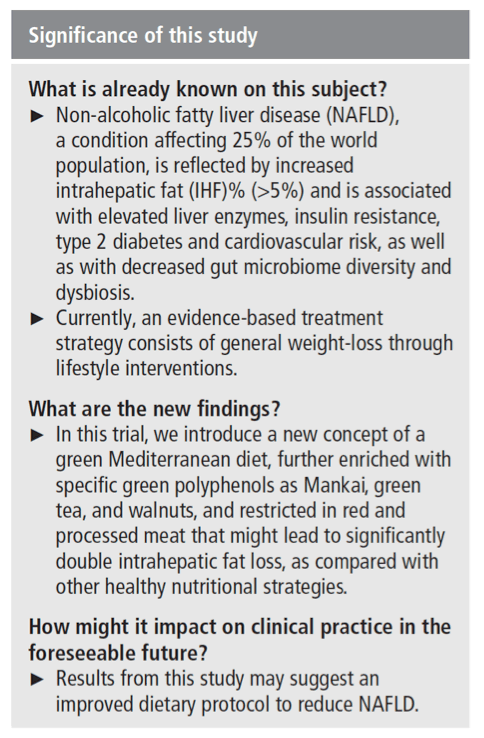| |
NAFLD Management - Effect of green-Mediterranean diet on intrahepatic fat: the DIRECT PLUS randomised controlled trial
|
| |
| |
Download the PDF here
AASLD: What Are the Current Treatment Options for our Patients with NAFLD/NASH ? - (12/01/20)
Cancer Risk in Patients With Biopsy-Confirmed Nonalcoholic Fatty Liver Disease: A Population-Based Cohort Study - (05/3/21)
Forty-one (12%) of PWH without viral hepatitis had elevated LSM assessed by transient elastography compared to 154 (7%) population controls. - Non-Viral Liver Disease in HIV+ - Increased Prevalence of Liver Fibrosis in PLWH Increased Prevalence of Liver Fibrosis in People Living With Human Immunodeficiency Virus Without Viral Hepatitis Compared to Population Controls - (03/02/21)
Hepatic Fibrosis Associates With Multiple Cardiometabolic Disease Risk Factors: The Framingham Heart Study - (02/10/21)
AASLD: PREVALENCE AND RISK FACTORS OF HEPATIC STEATOSIS AND FIBROSIS IN AMERICAN ADULTS: A POPULATION-BASED STUDY - (12/21/20)
———————————————
In conclusion, a green-MED diet, enriched with specific polyphenols and decreased red and processed meat consumption, amplifies the beneficial effect of the MED diet on hepatic fat reduction, beyond weight loss. The results of this study may suggest an improved dietary protocol to treat NAFLD.

Abstract
Objective To examine the effectiveness of green-Mediterranean (MED) diet, further restricted in red/processed meat, and enriched with green plants and polyphenols on non-alcoholic fatty liver disease (NAFLD), reflected by intrahepatic fat (IHF) loss.
Design For the DIRECT-PLUS 18-month randomized clinical trial, we assigned 294 participants with abdominal obesity/dyslipidaemia into healthy dietary guidelines (HDG), MED and green-MED weight-loss diet groups, all accompanied by physical activity. Both isocaloric MED groups consumed 28 g/day walnuts (+440 mg/day polyphenols provided).
The green-MED group further consumed green tea (3-4 cups/day) and Mankai (a Wolffia globosa aquatic plant strain; 100 g/day frozen cubes) green shake (+1240 mg/day total polyphenols provided).
IHF% 18-month changes were quantified continuously by proton magnetic resonance spectroscopy (MRS).
Results Participants (age=51 years; 88% men; body mass index=31.3 kg/m2; median IHF%=6.6%; mean=10.2%; 62% with NAFLD) had 89.8% 18-month retention-rate, and 78% had eligible follow-up MRS.
Overall, NAFLD prevalence declined to: 54.8% (HDG), 47.9% (MED) and 31.5% (green-MED), p=0.012 between groups.
Despite similar moderate weight-loss in both MED groups, green-MED group achieved almost double IHF% loss (-38.9% proportionally), as compared with MED (-19.6% proportionally; p=0.035 weight loss adjusted) and HDG (-12.2% proportionally; p<0.001).
After 18 months, both MED groups had significantly higher total plasma polyphenol levels versus HDG, with higher detection of Naringenin and 2-5-dihydroxybenzoic-acid in green-MED.
Greater IHF% loss was independently associated with increased Mankai and walnuts intake, decreased red/processed meat consumption, improved serum folate and adipokines/lipids biomarkers, changes in microbiome composition (beta-diversity) and specific bacteria (p<0.05 for all).
Conclusion The new suggested strategy of green-Mediterranean diet, amplified with green plant-based proteins/polyphenols as Mankai, green tea, and walnuts, and restricted in red/processed meat can double IHF loss than other healthy nutritional strategies and reduce NAFLD in half.
Introduction
Intrahepatic fat (IHF) accumulation, a result of intracellular triglyceride (TG) deposition in the liver, is promoted by bodily adipose tissue dysfunction and insulin resistance.1 IHF that exceeds 5%, in the absence of alcohol abuse, defines non-alcoholic fatty liver disease (NAFLD).2 IHF accumulation is associated with elevated liver enzymes, insulin resistance, type 2 diabetes, cardiovascular risk and extrahepatic malignancies.2 3
In recent years, the gut microbiome was suggested to have a pivotal role in NAFLD pathogenesis. This association is presumably due to the modulation of hepatic carbohydrate and lipid metabolism, with dysbiosis, that is, aberrant composition of the microbiome community, being a hallmark of the disease.4 5 NAFLD affects about a quarter of the world population6 and can progress to the development of steatohepatitis, liver-cirrhosis and hepatocellular carcinoma.2 7 The current evidence-based treatment strategy consists of weight-loss through lifestyle interventions,8 without specific dietary recommendations, although strong evidence points toward recommending the Mediterranean (MED) diet.9 MED diet, relatively rich in plant food sources, has been associated with reduced prevalence of NAFLD,10 improves cardiometabolic and cardiovascular biomarkers, and reduces all-cause mortality.11-13
Polyphenols, secondary metabolites of plants with antioxidant properties, are involved in the defence against ultraviolet radiation and pathogenic insults in the plants and have been suggested, in humans, to be protective against several malignancies, cardiovascular diseases, diabetes, osteoporosis and neurodegenerative diseases,14 as well as reducing hepatic steatosis.15 The main groups of polyphenols are classified by the number of phenol rings they contain and structural elements and include phenolic acids, flavonoids, stilbenes and lignans.14 The MED diet has a relatively high content of polyphenols. In the traditional Spanish MED diet, the mean polyphenol intake was estimated to be between ~2500 and 3000 mg/day16 as compared with ~1000 mg/day in a western-style diet.17 We, and others, reported a greater decrease in NAFLD with MED diet, as compared with a low-fat diet.3 18 19 Adherence to vegetarian and plant-based diets was also associated with a lower incidence of NAFLD.20 21
In the current 18-month Dietary Intervention Randomized Controlled Trial Polyphenols Unprocessed (DIRECT PLUS), we aimed to examine the effect of MED diet, further enriched with polyphenols and lower in red and processed meat (‘green-MED’), on IHF changes, as measured by proton magnetic resonance spectroscopy (H-MRS). Our a priori hypothesis was that a green-MED diet may promote further effectiveness in treating NAFLD, beyond the expected beneficial effects of the MED diet.
| |
| |
| |
|
|
|